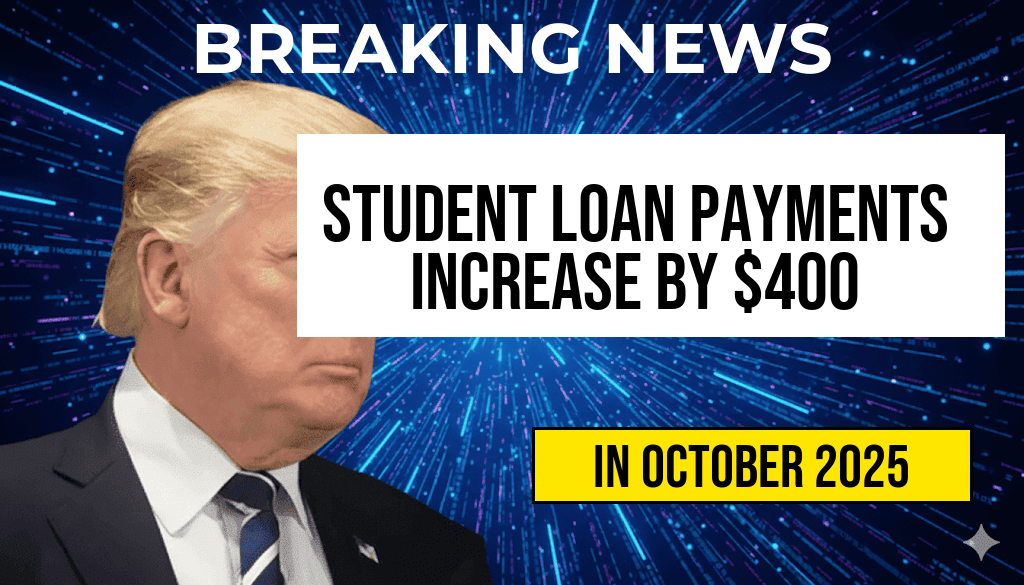Student Loan Payments Surge by $400 Monthly for Millions—Here’s Who Will Feel the Impact First
Millions of Americans preparing to resume student loan payments face a significant financial shift as monthly bills are expected to increase by approximately $400 per borrower. This substantial rise stems from the end of a temporary federal relief measure that paused student loan repayments during the COVID-19 pandemic. With payments set to restart in the coming months, many borrowers—including recent graduates, low-income individuals, and those with high debt loads—will feel the strain first. Experts warn that this surge could influence personal finances, credit scores, and even the broader economy, prompting some to reevaluate their budgets and repayment strategies.
Background: The End of Pandemic Relief and Its Immediate Effects
During the pandemic, the federal government implemented broad measures to ease financial burdens, including a pause on student loan payments and a 0% interest rate on federally-held loans. These provisions provided temporary relief to over 43 million borrowers, many of whom benefited from ongoing forbearance periods that extended into late 2023. However, as the U.S. aims to restore normalcy, these measures are expiring, marking a pivotal moment for borrowers nationwide.
Starting in the upcoming months, borrowers will be required to resume regular payments, which, for many, will mean an increase of about $400 per month. This figure is an estimate based on average federal student loan debt and typical repayment terms, though individual amounts will vary depending on loan balance, repayment plan, and interest rates. The transition is expected to be particularly challenging for borrowers with limited savings or fixed incomes.
Who Will Feel the Impact First?
The initial wave of financial hardship will likely hit specific groups more acutely than others. These include:
- Recent graduates: Many entered the workforce during the pandemic and may have limited income or job stability, making the added expense difficult to manage.
- Low-income borrowers: Those earning below median income levels often rely heavily on federal assistance programs and may lack the financial buffers needed to absorb increased payments.
- Borrowers with high debt-to-income ratios: Individuals carrying significant student debt relative to their earnings will experience a more noticeable impact on their budgets.
- Public service and income-driven plan participants: Although some of these borrowers may have payment reductions or forgiveness options, many will still face higher monthly obligations once repayment resumes.
Financial and Broader Economic Implications
The looming increase in monthly payments could have ripple effects across personal finances and the economy. For some borrowers, the added expense may lead to:
- Reduced discretionary spending: Scarcity of funds could mean fewer purchases in retail and hospitality sectors, which are already sensitive to economic shifts.
- Delayed major financial milestones: Homeownership, car purchases, or saving for retirement might be postponed due to tighter budgets.
- Increased default risk: Borrowers with limited financial cushions could struggle to keep up, raising concerns about delinquencies and credit report impacts.
| Income Group | Average Monthly Payment Before Increase | Projected Monthly Payment After Increase | Estimated Increase |
|---|---|---|---|
| Low Income (<$40,000/year) | $200 | $600 | $400 |
| Middle Income ($40,000–$80,000/year) | $300 | $700 | $400 |
| High Income (>$80,000/year) | $400 | $800 | $400 |
Strategies for Navigating the Payment Resumption
Borrowers are encouraged to review their repayment options proactively. Federal student loan programs offer various plans that can help manage the increase, including:
- Income-driven repayment plans: These adjust monthly payments based on income and family size, potentially reducing the immediate burden.
- Loan consolidation: Combining multiple loans could simplify payments and potentially lower monthly amounts.
- Refinancing options: Private lenders may offer lower interest rates, but applicants should weigh the loss of federal loan protections.
Financial counseling services and resources from the U.S. Department of Education provide guidance tailored to individual circumstances. Borrowers should assess their budgets and consider reaching out early to avoid missed payments or default, which can have long-term consequences.
Looking Ahead
The return to standard student loan repayment marks a significant shift in the economic landscape for millions. While some borrowers may absorb the increase without major disruption, others face a period of financial adjustment. Policymakers and financial institutions are closely monitoring the situation, considering potential measures to ease the transition, such as targeted relief programs or flexible repayment options.
As the repayment period approaches, staying informed and planning ahead will be crucial. Resources like the [Federal Student Aid](https://studentaid.gov/) website offer up-to-date information, while consulting with financial advisors can help borrowers develop sustainable repayment strategies.
Frequently Asked Questions
Question
Which students or borrowers will experience the biggest increase in their student loan payments?
Question
What factors are contributing to the surge in monthly payments by approximately $400 for millions of borrowers?
Question
When will the payment increases take effect, and how long will they last?
Question
Are there options available for borrowers who are concerned about the payment hike or unable to afford the increased amount?
Question
How might this payment surge impact borrowers’ financial planning and overall economic stability?

Leave a Reply